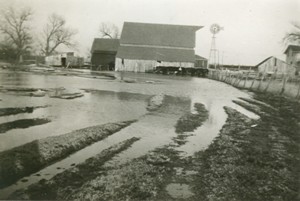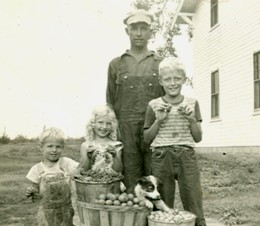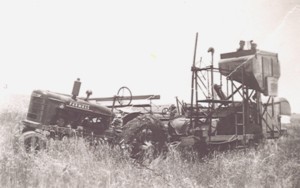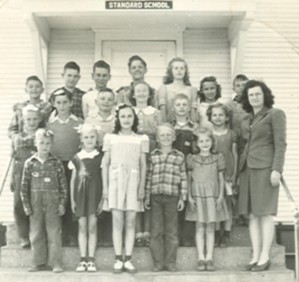|
For other farm equipment, Bill saved money by buying used implements,
some of which had been built for horsepower. He acquired a mower for
cutting hay and grass, and a two-section drill for sowing wheat. Both
the mower and the drill originally had had long tongues for pulling
by horses. Bill cut the tongues of these implements short and fixed
them to be attached to the pull bar of the "H." He also bought a used
plow, a used harrow, and a used "springtooth" cultivator. In about
1948, when he bought a used wheat combine from Daniel "Bubber" Goering,
he was able to harvest his wheat crop as soon as it was ripe, rather
than being dependent on his wider family.
Wheat was by far the most profitable crop in Kansas, although Bill
experimented with smaller plantings of oats, corn, milo, and other
green forage crops. One small ten-acre field ("behind the tracks")
was still unbroken prairie grass, which, in a good year, produced
two crops of hay for feeding the cattle over the winter. In the 1940s
the crop of alfalfa became popular, both because it was more nutritious
for animals and because it could produce three or four crops per year--depending
on adequate rainfall. So Bill plowed up the remaining prairie and
planted it to alfalfa. Unlike many farmers in the area, Bill did not
build a silo to store chopped green crops ("ensilage") for feeding
livestock. He preferred hay and alfalfa.

The flooded pasture, looking east
The grass on the pasture land that bordered the Dry Turkey Creek
on the Juhnke farm was generally sufficient for about twenty cows,
and one or two horses, to graze through the summer. There were a few
beef cattle, but mostly non-purebred milk cows. Bill gradually increased
his herd of milk-producing cows to a peak of about twelve. The labor
of milking by hand was the major constraint. Bill and Meta did the
milking in the mornings; Jim helped in the evenings from the time
that he started, aged eight or nine. In about 1947 or 1948 Bill and
Meta bought a DeLaval milking machine from the Elyria Lumber and Mercantile
Store. The machine traumatized the cows for the first several weeks
of use. The milk went into buckets (not a bulk tank), and the milkers
carried it to a separate milk house for separating the cream. The
skim milk was fed to the calves and pigs. The cream went into five-gallon
cans for weekly pickup by the Moundridge Creamery. Meta made a lot
of cottage cheese and cream-rich pastries for the family.
Bill and Meta raised chickens for meat and for eggs. In the early
years they used some laying hens to incubate and hatch the eggs, a
method that was both inexpensive and inefficient. Soon they began
purchasing small flocks (fifty or so) of day-old chicks and feeding
them in a small "chicken house" on the southwest side of the farmstead.
After a certain age, the chickens were given the run of the farmyard--except
for the garden and the small lawn in front of the house. The prospective
laying hens had a chance for a decent existence. The family ate a
lot of eggs, and took the extras to Jonas Stucky's store (another
cousin) in McPherson for sale on the weekly trip to the city. But
the roosters were doomed. Meta supervised the butchering. She taught
her children how to hold the young mature birds over a wood stump,
chop off their heads with a corn knife, hold them down while the blood
spurted out, plunge them into a bucket of very hot water, pull off
their feathers, and remove their innards-saving the heart, liver,
and gizzard. Chicken meat was a delicacy often served to family and
guests for the Sunday noon meal.
Bill and Meta also raised hogs, with three or four porkers usually
in the pen being fattened for butchering. The hogs grew up on skim
milk, kitchen slops, and "mash" made up of ground oats or corn. Hog
butchering day, often in late fall, was great social occasion. Grandparents,
aunts, uncles and families came for the event. Everyone seemed to
have assigned roles. Bill supervised the killing and scalding of the
hogs, and cut them open. Meta prepared the meat cutting table, and
fixed the noon meal, including delicious tenderloin and a famous dish
of liver, onions and brains. Grandma Alvina Juhnke scraped and cleaned
the small intestines to be used for sausage casings. One of the uncles,
such as Carl Juhnke or Reuben Krehbiel, cut up the pigs' heads. The
children kept the fire hot for the cauldron that boiled the meat for
liver sausage, pork sausage, and, finally, boiled down the fat into
lard.
When they began farming, Bill and Meta had a mechanical cream separator
that needed to be turned by hand. Jim remembers one time when he,
probably too young for the job, was assigned to turn the separator
handle and managed to tip over the mechanism and spill the milk onto
the floor. It was a major advance when Bill and Meta bought an electricity
powered cream separator, but it was still a lot of work both morning
and evening to assemble and disassemble the separator parts and to
wash them in hot water.
Meta's initial equipment for washing clothes was primitive by modern
standards. She had a washtub for washing the clothes, with a double-roller
mechanism fixed to one corner for squeezing out the soapy water. Then
the clothes were rinsed in another tub of clear water, and once again
squeezed through the rollers. One had to be careful to insert the
clothes into the rollers at a manageable pace, and not to get one's
hand into the rollers. That was a two-person job. Jim remembers getting
his hands in the wringer more than once, and having his mother free
him with the release mechanism. Eventually Meta got a more modern
washing machine, but she always hung the clothes out to dry on the
clothesline south and east of the house. It was an important day when
the rickety old wooden clothesline frames and loose lines were replaced
by metal pipe frames with cement foundations.
The Juhnke house was old (built about 1925) and drafty. It was heated
with a whole house wood stove in the basement. In winter time Bill
and Meta closed the stove vents so that the large kitchen was the
only room heated in the house--except for the bathroom for Saturday
evening baths. Perhaps the most important home improvement project
was a set of built-in cabinets and new sink on the south wall of the
kitchen. Henry J. Goering, Meta's uncle who lived in Elyria, was a
carpenter who put in the new cabinets. Other important additions included
an electric refrigerator and a new piano.
Living on the farm full time, Bill and Meta were able to expand the
size of their garden south of the house. (See an outline
of the farmstead in Chapter 1.) Potatoes were the garden crop
that produced the most food for the table, but the garden also included
radish, carrots, lettuce, green beans, beets and poppy. There were
also cucumbers and cabbage-for making pickles and sauerkraut. Later
in life, Meta reminisced with some amazement about her diligence:
"And the garden. . . . I canned beans. Forty quarts. Horrors!!" When
they tore down the shed just north of the entrance to the farmstead,
Bill and Meta planted potatoes on that site as well. The soil there
was especially fertile because the shed had been used many years as
a pig lot. They planted corn-both sweet corn and popcorn--at "the
other place"--a mile east and a mile and a quarter north of the farmstead,
where Uncle Wesley Juhnke had lived before selling that place to his
brother, Ernest Juhnke. Eventually Bill and Meta expanded their home
garden southward and added fruit trees-sour cherry, peach, apricot,
apple and pear. The cherry trees seemed to be most successful. The
planting, cultivating, harvesting and preserving of garden products
were labor intensive. The weather in Kansas was not reliable. A spring
drought and early summer heat could drastically reduce garden production.

Bill Jr., Janet, Bill St., and Jim, returned from an expedition
to collect wild grapes, walnuts, and sand-hill plums. Summer 1947.
Meta's household was a model of frugality. She reused and recycled
everything, including wax paper from cereal boxes and plastic wrap
from bought bread. She used fat drippings to make lye soap. She mended
and patched clothes, and then made them over for younger children.
Threadbare clothes eventually wound up as rags for cleaning or for
fashioning into rag rugs. Flour sacks became tea towels. Leftover
material from sewing dresses found its way into quilts.
Meta and Bill had two more children on the farm and one more was
on the way when they moved to Lehigh in the fall of 1950. William
Ernest, Jr. was born January 26, 1945. That was a difficult breech
birth. Meta said she could feel her uterus tear: "It felt like a hot
knife slicing." She approached her subsequent pregnancies with trepidation,
but they all went quite well. Sharon Kay was born July 13, 1948--the
same birthday as her Grandma Alvina Juhnke. Ruth Elinor Juhnke was
born in the McPherson hospital on Christmas Eve, December 24, in 1950.
These births were part of a wider family population explosion. In
the six years between Buhler and Lehigh--1944 to 1950--Bill and Meta
and their siblings produced twenty-one children. The population explosion
continued apace in subsequent years. Over the decades, however, the
size of families decreased markedly on a clear generational pattern.
The grandparents (Ernest and Alvina Juhnke, Jonas and Katie Goering)
had had eleven and twelve children. The parents (Bill and Meta's generation)
generally had five or six children. These children in turn generally
produced only two or three children. This pattern corresponded the
wider world's declining birth rates in the transition from rural to
urban, traditional to modern, and agricultural to industrial ways
of life.
Meta loved her role as mother, gardener, and homemaker. She said
she did not find her situation confining. She never was tempted to
look for a wage-earning job outside of the home. Delbert Preheim,
her brother-in-law, wrote in one letter with apparent amused disbelief
that Meta "speaks of staying home with the kids as if it were the
acme of contentment--a sort of nirvana one attains to." Delbert, no
doubt, was thinking about all those dirty cloth diapers, snotty-nosed
and illness-prone kids, and unending chores of house-cleaning, meal
preparation, farmyard work, and gardening.
|





